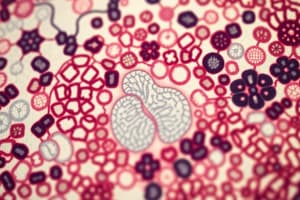Podcast
Questions and Answers
What is the main function of epithelial tissue in the body?
What is the main function of epithelial tissue in the body?
- Protecting and regulating the passage of substances (correct)
- Facilitating the transmission of nerve impulses
- Providing support and binding organs together
- Generating movement and maintaining posture
Which type of tissue is responsible for generating movement, maintaining posture, and producing heat via contraction?
Which type of tissue is responsible for generating movement, maintaining posture, and producing heat via contraction?
- Nervous tissue
- Epithelial tissue
- Muscle tissue (correct)
- Connective tissue
What does histology study focus on when examining tissues?
What does histology study focus on when examining tissues?
- Detecting various tissue types based on color differences
- Revealing the microscopic structure and organization of tissues (correct)
- Measuring the strength and shape of muscle tissue
- Identifying the components of connective tissue
Which type of tissue is characterized by its extracellular matrix and the presence of fibroblasts and macrophages?
Which type of tissue is characterized by its extracellular matrix and the presence of fibroblasts and macrophages?
What is the function of nervous tissue in the body?
What is the function of nervous tissue in the body?
What is the main function of epithelial tissue in the body?
What is the main function of epithelial tissue in the body?
Which type of cells help in removing damaged cells and pathogens during the body's response to injury?
Which type of cells help in removing damaged cells and pathogens during the body's response to injury?
What is the main role of muscle tissue in the body?
What is the main role of muscle tissue in the body?
Which type of tissue facilitates communication between cells and the brain?
Which type of tissue facilitates communication between cells and the brain?
What type of cells differentiate into the cell types required for tissue repair?
What type of cells differentiate into the cell types required for tissue repair?
Flashcards are hidden until you start studying
Study Notes
Tissues: A Peek into the Building Blocks of Life
Tissues are the basic structural and functional units in living organisms, forming a complex network that defines our body's organization. They can be thought of like architectural scaffolding, providing shape, strength, and specialized tasks.
Types of Tissues
There are four main types of tissues:
- Epithelial tissue: Covers the body's external and internal surfaces, lining the cavities and organs. It protects and regulates the passage of substances, such as water and nutrients.
- Connective tissue: Provides support, binds organs together, and facilitates communication between cells. It includes subtypes like cartilage, bone, and blood.
- Muscle tissue: Generates movement, maintains posture, and produces heat via contraction. It is categorized into three types: skeletal, smooth, and cardiac muscle.
- Nervous tissue: Composed of neurons and neuroglia, it facilitates the transmission of nerve impulses and communication between cells.
Histology of Tissues
Histology is the microscopic study of tissues, which reveals their structure and organization. The examination of tissue samples using a microscope allows us to distinguish various tissue types and identify their components.
For instance, epithelial tissue appears as a tightly packed sheet of cells with a distinct basement membrane. Connective tissue, on the other hand, is characterized by its extracellular matrix and the presence of cells like fibroblasts and macrophages.
Cell Types in Tissues
Each tissue type is composed of specialized cells with unique characteristics and functions. For example, muscle fibers are long and cylindrical, while neurons have a complex structure and long processes to facilitate communication.
The interaction between cells and their extracellular environment is crucial in maintaining tissue function. For instance, the basement membrane in epithelial tissue provides structural support and helps regulate cell migration.
Functions of Tissues
Tissues work together to ensure the body's proper functioning. They perform various tasks:
- Protection: Epithelial and connective tissues, like the skin and cartilage, protect the body from external threats.
- Support: Connective tissues, such as bone and cartilage, maintain the body's structure.
- Movement: Muscle tissue generates movement and maintains posture.
- Excretion: Tissues like the kidney and liver eliminate waste products and regulate the body's fluid balance.
- Absorption: Epithelial tissues, like the small intestine, absorb nutrients and water.
- Communication: Nervous tissue facilitates communication between cells and the brain.
- Transportation: Blood vessels transport oxygen, nutrients, and waste products throughout the body.
Tissue Repair
Tissue repair is a vital process, allowing tissues to recover from damage and maintain their function. The body's response to injury involves inflammation, the formation of new tissue, and tissue remodeling.
- Inflammation: Inflammatory cells like macrophages and neutrophils help remove damaged cells and pathogens.
- Formation of new tissue: Stem cells and progenitor cells differentiate into the cell types required for repair.
- Tissue remodeling: The extracellular matrix is rebuilt, and the tissue is reorganized to restore its original structure and function.
Tissues are the building blocks of life, each with its unique structure and function. Their study provides valuable insights into the mechanisms behind health and disease that are essential in understanding and improving human health.
Studying That Suits You
Use AI to generate personalized quizzes and flashcards to suit your learning preferences.




